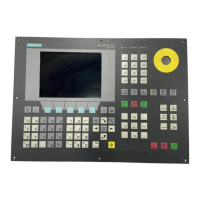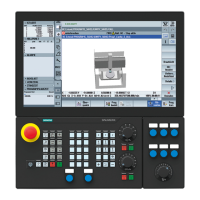Tool offsets
7.5 Activate 3D tool offsets (CUT3DC..., CUT3DF...)
Job planning
418 Programming Manual, 07/2010, 6FC5398-2BP40-0BA0
Further Information
Intersection procedure for 3D compensation
With 3D circumferential milling, G code
G450/G451 is now evaluated i.e. the point of inter-
section of the offset curves can be approached. Up to SW 4 a circle was always inserted at
the outside corners. The intersection procedure is especially advantageous for 3D programs
typically generated by CAD. These often consist of short straight blocks (to approximate
smooth curves), where the transitions between adjacent blocks are almost tangential.
Up to now, with tool radius compensation on the outside of the contour, circles were
generally inserted to circumnavigate the outside corners. These blocks can be very short
with almost tangential transitions, resulting in undesired drops in velocity.
In these cases, analog to the 2 ½ D radius compensation, the two curves involved are
extended; the intersection of both extended curves is approached.
The intersection is determined by extending the offset curves of the two participating blocks
and defining the intersection of the two blocks at the corner in the plane perpendicular to the
tool orientation. If there is not such intersection, the corner is handled as before – i.e. a circle
is inserted.
For more information on the intersection procedure, see:
References:
Function Manual, Special Functions; 3D Tool Radius Compensation (W5)
7.5.6 3D tool offset: 3D circumferential milling with limitation surfaces
Adaptation of 3D circumferential milling to the conditions for CAD programs
NC programs generated by CAD systems usually approximate the center path of a standard
tool with a large number of short linear blocks. To ensure that the blocks of many part
contours generated in this way map the original contour as precisely as possible, it is
necessary to make certain changes to the part program.
Important information, which would be required to achieve optimum compensation, that is no
longer available in the part program must be replaced using suitable measures. Here are
some typical methods to compensate critical transitions, either directly in the part program or
when determining the real contour (e.g. using tool infeed).
Applications
In addition to the typical applications for which instead of the standard tool, a real tool
describes the center-point path, cylindrical tools with 3D tool compensation are also
described. In this case, the programmed path refers to the contour on the machining surface.
The associated limitation surface is independent of the tool. Just the same as for
conventional tool radius compensation, the entire radius is used to calculate the
perpendicular offset to the limitation surface.

